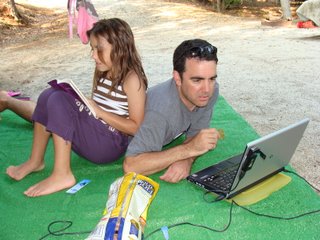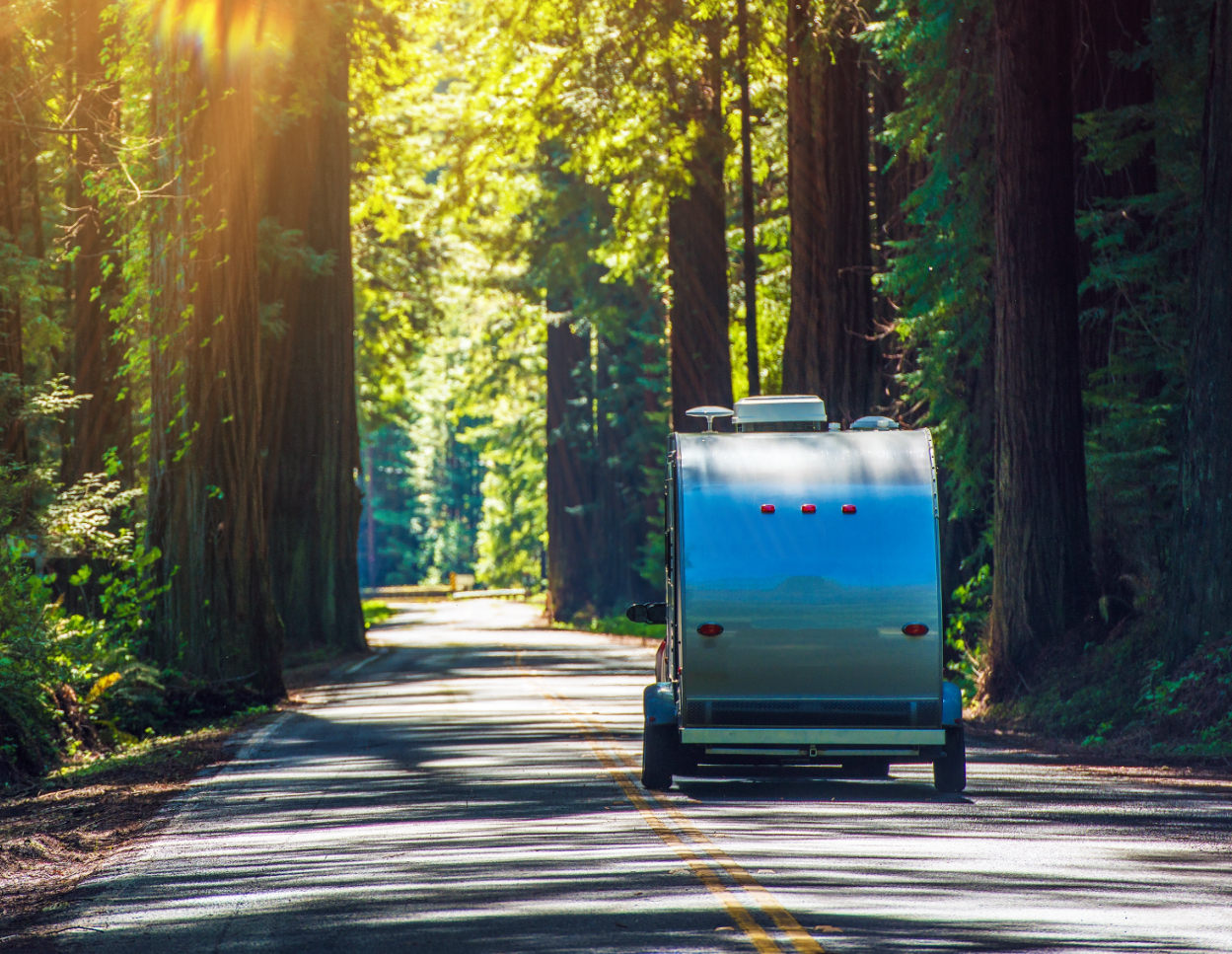
When I tell people that we’re embarking on a two-week workation adventure in a 25-foot recreational vehicle — “balk” is the best word to characterize their surprise.
Cramped. Constricted. Confined.
Confused.
But working from an RV traveling the American South is anything but any of those.
I guess a workation is what you make of it. With broadband wireless, netbook and laptops, and all the trappings of modern life — tucked neatly into a late-model RV, we’ll have what we need to stay connected and for me to get my job done.
Want crazy? Camping retailer REI says the sale of single-family tents were up 17% this June over last. That’s crazy? Where will you put the 23-inch TV?
Surely I jest. I grew up tent camping throughout Florida. Good times.
But still need convincing about the beauty of RV’ing, tent-camping and even the use of air-conditioned cabins? Read on in this article from USAToday on the surprising pleasures of modern RV’ing…“At the Battlefield KOA Campground here, you can catch up on e-mail at your campsite, take in an evening movie on a 9-foot inflatable outdoor screen, lounge by the pool, play a round of mini golf or try your hand at Extreme Hunting, one of the arcade games in the game room. There’s live music on Saturday nights and pancake breakfasts on weekend mornings, and if you don’t feel like cooking, you can have dinner delivered to your RV door, tent flap or what-have-you…
“Heck, you don’t even have to really camp at this wooded 25-acre site, thanks to its growing inventory of air-conditioned cabins, cottages and lodges essentially, tricked-out trailers done up to look like hand-hewn log dwellings.
“So much for getting away from it all,” owner John Bergeron says with a laugh.
But getting away they are. By many accounts, business is brisk this summer at campgrounds nationwide. The sinking economy may have put the brakes on taking the Grand Tour, but many Americans still want to get away. And with relatively low gas prices, more people are pulling into campgrounds.
Campground reservations through ReserveAmerica.com, which books campsites in most national parks, are up 8% over last year in the first six months of 2009.
KOA Kampgrounds of America, a network of 460 commercial campgrounds, reports a 5% increase in June occupancy. REI, an outdoor-gear chain, says sales of family tents were up 17% in June over last year. The retailer also saw double-digit increases in sales of related products, such as air mattresses and campground stoves.
A recent survey by the Outdoor Foundation, a non-profit group that promotes outdoor activities, indicates camping’s popularity rose 7.4% in 2008 after a decline the year before. Overnight backpacking grew by 18.5%, the group reports.
“People are returning to simpler lifestyles the ‘less is more’ ethic,” says the foundation’s Christine Fanning. “And everyone is searching for vacations that fit with today’s economy.”
Indeed, ForestCamping.com, a comprehensive guide to U.S. National Forest campgrounds, where campsites go for $10 to $15 a night, has seen a spike in hits. Bookings for reservable Forest Service campsites were up 11% through May.
“When the economy goes down, camping goes up,” says Suzi Dow, who with her husband, Fred, runs the site.
David Berg, owner of the Red Apple Campground in Kennebunkport, Maine, echoes the sentiment. “I believe camping is a recession-proof business,” he says. “When people can’t afford $200 or $300 a night for a waterfront cottage, they dust off the pop-up (camper) or get out the tent and spend $50 a night on a campsite and maybe still go out to good restaurants.”
At Yellowstone National Park, lodging bookings are down this year, but campground stays are up, says Rick Hoeninghausen, marketing director for Xanterra, which runs the park’s concessions.
“This is an interesting summer because, even in April, reservations were trailing last year. Then it kicked in in May. There’s more last-minute decision-making this year than I can ever remember.”
As in other segments of the travel industry, campers are staying closer to home, but they’re also staying away longer. At KOA campgrounds, for instance, average stays are 2.5 nights, up from 1.7 nights three years ago.
RVTravel.com editor Chuck Woodbury has been traveling through Western parks this summer, and says he’s struck by the number of rental RVs on the road. “It’s families, it’s couples, it’s everyone,” he says. “RV’ing has become much more accepted. It’s not just Grandma and Grandpa’s playhouse anymore.”
Nor are today’s campgrounds necessarily like the ones you might remember as a kid. Food delivery, concierge services and skate parks are among innovative additions at some private facilities. In Columbia, Calif., the Marble Quarry RV Park features on-site gold panning. At Yogi Bear’s Jellystone Park Hill Country in Canyon Lake, Texas, laser tag is all the rage. At Kamp Klamath RV Park and Campground in Klamath, Calif., the alder-smoked salmon served at the park’s restaurant has won prizes in several competitions.
At Yogi Bear’s Jellystone Camp Resort & Water Playground in Wisconsin Dells, owner Brent Gasser has gradually expanded what began as a campground with basic tent sites to a “camp resort” with a four-level water playground, boat and golf cart rentals, themed weekends (think Christmas in July), and 51 rental units that go from $39 to $299 a night.
“The traditional camper has been requesting more and more accommodations that they’d find in a hotel,” Gasser says. “And since we’re in an area with many hotels, we have to compete.”
And at the Red Apple Campground, the annual $25 Maine lobster fest sells out two years in advance. This summer, bookings are up 9%, and the average stay has stretched from 2.5 to 4.5 days.
“You have to be more creative to get people in your park and get them to come back again,” Berg says. “Today’s customer wants it all. In the majority of campgrounds today, we have Wi-Fi and concierge services. There are (waterfront) campsites in Maine that go for over $100 a night. And they sell first.”
But the constant buzz of organized activity can be a bit much, even for avid campers such as Brian and Michelle Gillespey of Brownstone, Mich.
“They’re on the PA making announcements about putt-putt golf and the ice cream social at 3 p.m.,” she says.
“There are too many activities at some of these places,” he says. “To me, it’s not relaxing.”
What many campground denizens say they do like is the camaraderie of the camp. KOA president Jim Rogers calls campgrounds “the last small town in America. They’re a live community, a social beehive. You’re interacting with strangers and allowing your kids to.”
“A woman stepped onto our site to avoid a passing car last night and ended up staying until midnight,” says Lynn Boozel, a camper at the KOA in Gettysburg. Boozel and his wife, Rhonda, of McVeytown, Pa., are wrapping up their seventh annual week-long visit here. “We came for a weekend and got hooked,” Boozel says.
The couple, with their two young daughters and a granddaughter, are sleeping in a six-person tent, which puts them in the minority among the Hitchhikers, Wolf Packs and other RV models that occupy most of the sites.
Across the way, Valerie and Bill Stack of Donora, Pa., have just arrived in their Ford pickup pulling a 12,000 pound, 38-foot trailer. This is one of five trips they’ll make here this summer.
“Once you’re addicted to this, you can’t stay home,” Bill Stack says. “You come back and say, ‘Boy, did I have a great time,’ and they ask, ‘What did you do?’ and you say, ‘Nothing.’ ”
The trailer has a gas fireplace, queen-size bed and flat-screen TV, among other amenities. They’ll spend the weekend swimming in the pool and maybe play some putt-putt golf.
“But we’re here for nature,” Valerie Stack says. “If I lost everything tomorrow, I’d go out and buy a tent.”
